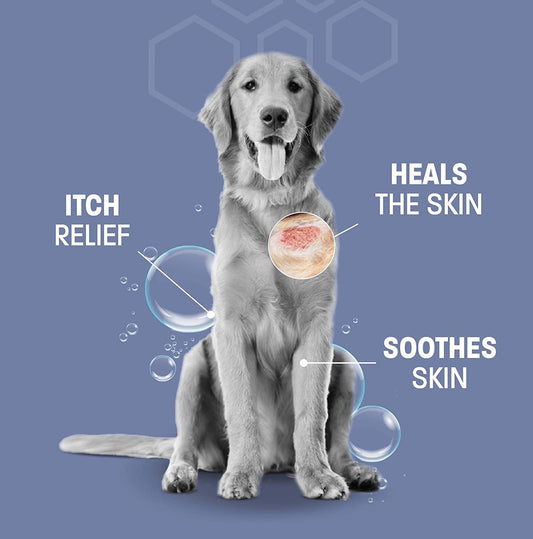Urinary Tract Infections can be a recurrent nightmare for many dogs. To combat this, Pet Health Pros offers a urinary tract supplement, a dietary solution that not only treats but also helps in preventing UTIs, promoting overall urinary health.
Are you a dog owner concerned about your furry friend's health? Have you noticed any symptoms of a urinary tract infection (UTI) in your dog? If so, you're not alone. UTIs are a common issue for dogs and can cause discomfort and potential health complications. In this article, we will explore the causes, symptoms, and treatment options for UTIs in dogs.
What Is a Urinary Tract Infection in Dogs?
A urinary tract infection (UTI) in dogs is an infection that affects the urinary system, which includes the bladder, urethra, and kidneys. This condition occurs when bacteria enter the urinary tract and multiply, causing discomfort and potential health issues for the dog.
Common signs of a UTI in dogs include:
- frequent urination
- difficulty urinating
- presence of blood in the urine
- accidents in the house
If you suspect your dog may have a UTI, it is important to seek advice from a veterinarian for an accurate diagnosis and treatment plan. Providing adequate water, frequent bathroom breaks, and a well-balanced diet can help prevent UTIs in dogs.
What Are the Types of UTIs in Dogs?
There are three types of urinary tract infections (UTIs) that can occur in dogs. These include:
- Lower urinary tract infections: These infections involve the bladder and urethra.
- Upper urinary tract infections: These infections affect the kidneys and ureters.
- Asymptomatic bacteriuria: In this type, bacteria are present in the urine but do not cause any symptoms.
It is important to identify the types of UTIs in dogs in order to determine the appropriate treatment and prevent complications. Regular veterinary check-ups can help in diagnosing and managing UTIs in dogs.
What Are the Causes of UTIs in Dogs?
Urinary tract infections (UTIs) are a common health problem in dogs, and understanding the causes is crucial in preventing and treating this condition. In this section, we will delve into the various reasons that can lead to UTIs in dogs. These include bacterial infections, urinary stones, and anatomical abnormalities in the urinary tract. By gaining a better understanding of these causes, we can take necessary precautions to keep our furry friends healthy and comfortable.
1. Bacterial Infections
Bacterial infections are a common type of urinary tract infection (UTI) in dogs. Here are steps to address and prevent them:
- Consult a veterinarian for a proper diagnosis through a urine culture and sensitivity test.
- Treat the infection with antibiotics prescribed by the veterinarian.
- Administer the antibiotics for the recommended duration, even if symptoms improve.
- Encourage increased water intake to promote frequent urination and flush out bacteria.
- Implement proper hygiene practices by regularly cleaning your dog's genital area.
- Consider adding cranberry supplements to your dog's diet, as they may help prevent bacterial infections.
By following these steps, you can effectively handle bacterial infections in dogs and reduce the likelihood of recurrence.
2. Urinary Stones
Urinary stones in dogs can be a source of discomfort and may even lead to urinary tract infections. To address this issue, here are the key steps to follow:
- Dietary changes: It is important to provide your dog with a balanced diet that is low in minerals that can contribute to the formation of stones.
- Increased water intake: It is crucial to encourage your dog to drink more water in order to dilute urine and promote flushing of the urinary system.
- Medication: In some cases, specific medications can be used to dissolve or prevent the growth of stones.
- Surgical removal: In severe cases or when stones are too large, surgery may be necessary to remove them.
3. Anatomical Abnormalities
Anatomical abnormalities in dogs can lead to urinary tract infections (UTIs). These abnormalities can be caused by structural issues or genetic defects that affect the urinary system. If your dog has anatomical abnormalities, here are some steps you can take to manage UTIs:
- Consult with a veterinarian to diagnose the specific abnormalities and understand their impact.
- Follow any recommended treatment plans, which may include surgery or medication.
- Maintain good hygiene by regularly cleaning your dog's genital area.
- Make sure your dog has plenty of water to encourage frequent urination and flush out bacteria.
Pro-tip: Regular check-ups with a veterinarian can help identify and monitor any underlying anatomical abnormalities, reducing the risk of UTIs in your dog.
What Are the Symptoms of UTIs in Dogs?
If you're a dog owner, it's important to be aware of the signs and symptoms of urinary tract infections (UTIs) in your furry companion. These infections can be uncomfortable and even dangerous for dogs if left untreated. In this section, we'll discuss the various symptoms of UTIs in dogs, including frequent urination, straining to urinate, blood in the urine, and a strong odor in the urine. By understanding these symptoms, you can better recognize when your dog may be suffering from a UTI and seek proper treatment.
1. Frequent Urination
Frequent urination in dogs can be a sign of a urinary tract infection (UTI). To address this issue, take the following steps:
- Observe your dog's urination patterns and note any increase in frequency.
- Provide ample opportunities for your dog to urinate, allowing them to relieve themselves regularly.
- Ensure your dog has access to fresh water at all times to promote hydration.
- Maintain proper hygiene by regularly cleaning your dog's genital area.
- Consult with a veterinarian to rule out any underlying medical conditions that may be causing frequent urination.
Remember, if you notice any concerning symptoms or changes in your dog's urination habits, it's important to seek veterinary care promptly for proper diagnosis and treatment.
2. Straining to Urinate
Straining to urinate is a common symptom of urinary tract infections (UTIs) in dogs. If your dog is experiencing this behavior, it is important to take appropriate steps to address the issue.
- Schedule a visit to the veterinarian to determine the underlying cause of your dog's straining to urinate.
- During the visit, the vet may perform a physical examination and conduct diagnostic tests, such as urine analysis or imaging, to diagnose the UTI.
- Follow the recommended treatment plan, which typically involves antibiotics to eliminate the infection.
- Encourage your dog to stay hydrated by drinking plenty of water, which can help flush out bacteria from the urinary tract.
- Monitor your dog's urination patterns and look out for any changes or signs of discomfort.
3. Blood in Urine
Blood in the urine is a concerning symptom that may be indicative of a urinary tract infection (UTI) in dogs. If you notice this sign, here are some steps you can take:
- Consult a veterinarian: Seek professional advice to diagnose the cause and severity of the UTI.
- Undergo diagnostic tests: Your vet may recommend urine analysis, blood tests, and imaging to further evaluate the condition.
- Follow prescribed treatment: Depending on the underlying cause, your vet may prescribe antibiotics, urinary acidifiers, or anti-inflammatory medications.
- Monitor urine color: Keep an eye on your dog's urine to track improvement. If the blood persists or worsens, contact your vet immediately.
- Encourage water intake: Adequate hydration helps flush out bacteria and promotes urinary tract health.
- Prevent future UTIs: Maintain proper hygiene, encourage regular urination, and schedule regular veterinary check-ups to catch any potential issues early.
4. Strong Odor in Urine
A strong odor in a dog's urine can be a sign of a urinary tract infection (UTI). If you notice this symptom, here are some steps to consider:
- Monitor their water intake: Encourage your dog to drink plenty of water to help flush out bacteria.
- Consult a veterinarian: Schedule a visit to have your dog examined and diagnosed.
- Collect a urine sample: Provide a urine sample to the veterinarian for analysis.
- Treatment with antibiotics: Your veterinarian may prescribe antibiotics to treat the infection and eliminate the strong odor.
- Follow-up care: Follow your veterinarian's instructions for administering medication and monitor your dog's progress.
How Are UTIs Diagnosed in Dogs?
Diagnosing urinary tract infections (UTIs) in dogs involves a multi-step process to accurately identify and treat the infection. Here is a breakdown of the diagnostic steps using ul tags:
- Physical examination: The veterinarian will perform a thorough examination of the dog, checking for any visible symptoms or signs of discomfort.
- Urinalysis: A urine sample is collected and analyzed for appearance, pH levels, presence of blood or bacteria, and other abnormalities.
- Urine culture: If the initial urinalysis shows signs of infection, a urine culture is performed to identify the specific bacteria causing the UTI and determine the most effective treatment.
- Imaging tests: In some cases, imaging tests such as X-rays or ultrasounds may be conducted to detect any structural abnormalities in the urinary tract.
- Additional tests: Depending on the dog's symptoms, additional tests such as blood work or urine protein tests may be performed to rule out other potential causes of urinary problems.
This comprehensive diagnostic approach helps veterinarians accurately diagnose and treat urinary tract infections in dogs.
What Is the Treatment for UTIs in Dogs?
Dealing with a urinary tract infection in your furry best friend can be a stressful and worrying experience. However, with prompt and proper treatment, your dog can make a full recovery. In this section, we will discuss the various treatment options for UTIs in dogs, including the use of antibiotics, dietary changes, and increased water intake. By understanding these treatment methods, you can make informed decisions about your dog's health and well-being.
1. Antibiotics
When it comes to treating urinary tract infections (UTIs) in dogs, antibiotics are essential. Here are some steps to consider:
- Consult a veterinarian to determine the appropriate antibiotic based on the specific infection.
- Administer the prescribed antibiotics as directed, making sure to complete the full course of treatment.
- Monitor your dog for any adverse reactions to the antibiotics and report them to your vet.
- Provide your dog with plenty of fresh water to help flush out bacteria from the urinary tract.
- Follow any additional recommendations from your vet, such as dietary changes or supplements to support urinary health.
2. Dietary Changes
When it comes to treating urinary tract infections (UTIs) in dogs, incorporating dietary changes can be beneficial. Here are some steps to consider:
- Consult a veterinarian: Before making any dietary changes, it's important to consult with a veterinarian to determine the best approach.
- Switch to a prescription diet: Veterinarians may recommend a special prescription diet formulated to promote urinary health and prevent UTIs.
- Increase water intake: Encouraging your dog to drink more water can help flush out bacteria and reduce the risk of UTIs. Adding water to their dry food or using wet food can help increase their hydration.
- Avoid certain foods: Some foods, such as those high in magnesium or phosphorus, can contribute to the formation of urinary stones. Avoiding these foods can help prevent UTIs.
- Monitor weight and portion sizes: Maintaining a healthy weight is important for overall urinary health. Ensure your dog is getting the appropriate portion sizes to prevent obesity and urinary issues.
3. Increased Water Intake
Increasing water intake is crucial for managing and preventing urinary tract infections (UTIs) in dogs. Here are some steps to help increase your dog's water intake:
- Provide fresh water: Ensure your dog has access to clean, fresh water at all times.
- Multiple water sources: Place water bowls in different areas of your home to encourage your dog to drink more often.
- Add flavor: Some dogs may be enticed to drink more if you add a small amount of low-sodium chicken broth or wet food to their water.
- Water-rich food: Include wet or moist food in your dog's diet, as it contains a higher water content.
- Water fountains: Consider investing in a pet water fountain, as the flowing water can attract dogs and encourage them to drink more.
- Regular bathroom breaks: Take your dog outside frequently to encourage urination and prevent urine from sitting in the bladder for too long.
By following these steps, you can increase your dog's water intake and help prevent UTIs.
How Can UTIs Be Prevented in Dogs?
As a dog owner, it is important to be aware of the potential for urinary tract infections (UTIs) in your furry companion. Not only can UTIs cause discomfort and pain for your dog, but they can also lead to more serious health issues if left untreated. The good news is, there are several preventative measures that can be taken to reduce the risk of UTIs in dogs. In this section, we will discuss three key methods for preventing UTIs in dogs: encouraging frequent urination, maintaining proper hygiene, and scheduling regular veterinary check-ups.
1. Encourage Frequent Urination
Encouraging frequent urination in dogs can help prevent urinary tract infections. Here are some steps to promote this healthy habit:
- Take your dog for regular walks or outdoor breaks to allow them to relieve themselves.
- Create a consistent routine for bathroom breaks, especially after meals, naps, or playtime.
- Provide access to a clean and easily accessible outdoor area where your dog feels comfortable urinating.
- Use positive reinforcement techniques, such as treats and praise, to reward your dog for urinating outside.
- Ensure that your dog has access to fresh water throughout the day to encourage hydration and frequent urination.
2. Proper Hygiene
Proper hygiene is essential in preventing urinary tract infections (UTIs) in dogs. To maintain good hygiene, follow these steps:
- Regular bathing: Keep your dog clean by regularly bathing them with a dog-friendly shampoo.
- Clean genital area: After your dog urinates or defecates, gently clean their genital area to prevent bacteria buildup.
- Frequent grooming: Trim the hair around the genital area to decrease the chance of bacteria becoming trapped.
- Provide clean water: Make sure your dog always has access to fresh, clean water to promote hydration and urinary health.
Remember, maintaining a clean and healthy environment and following proper hygiene practices can greatly reduce the risk of UTIs in dogs.
3. Regular Veterinary Check-ups
Regular veterinary check-ups are essential for preventing and detecting urinary tract infections (UTIs) in dogs. Here are some steps to follow during these check-ups:
- Schedule regular check-ups: Ensure that your dog visits the veterinarian at least once a year for a comprehensive examination.
- Discuss urinary health: During the check-up, communicate any concerns or changes in your dog's urination habits.
- Urinalysis: The veterinarian may perform a urinalysis to check for any signs of infection or abnormalities in the urine.
- Physical examination: The vet will conduct a thorough physical examination of your dog's urinary system, looking for any signs of infection or other issues.
- Preventive measures: The vet may recommend preventive measures such as regular hygiene practices and dietary changes to reduce the risk of UTIs.
Regular veterinary check-ups are crucial in maintaining the overall health and well-being of your dog, including monitoring and managing urinary tract infections.
With Pet Health Pros, take a step forward in ensuring your dog's comfort and health. Our urinary tract supplement is your ally in the fight against UTIs, providing the care your dog needs to stay healthy and infection-free.
Frequently Asked Questions
What are the symptoms of Urinary Tract Infections in Dogs?
Some common symptoms of urinary tract infections in dogs include frequent urination, straining to urinate, blood in the urine, and excessive licking of the genital area. Other signs may include incontinence, lethargy, and loss of appetite.
How are Urinary Tract Infections in Dogs diagnosed?
To diagnose a urinary tract infection in dogs, a veterinarian will perform a physical examination and may also request a urine sample for analysis. They may also perform other tests such as a urine culture and blood work to determine the cause of the infection.
What causes Urinary Tract Infections in Dogs?
The most common cause of urinary tract infections in dogs is bacteria entering the urinary tract. This can happen through various ways such as bacteria traveling up the urethra, or through contaminated food or water. Other causes include underlying medical conditions such as bladder stones or tumors.
How are Urinary Tract Infections in Dogs treated?
Urinary tract infections in dogs are typically treated with antibiotics prescribed by a veterinarian. The length of treatment will depend on the severity of the infection. In addition to medication, it is important to ensure your dog is drinking plenty of water and to monitor their diet.
Can Urinary Tract Infections in Dogs be prevented?
While some urinary tract infections in dogs may be unavoidable, there are steps pet owners can take to help prevent them. These include providing clean drinking water, regular bathroom breaks, and maintaining good hygiene by keeping the genital area clean. It is also important to promptly treat any underlying medical conditions that may increase the risk of UTIs.
When should I take my dog to the veterinarian for a UTI?
If you notice any symptoms of a urinary tract infection in your dog, it is important to take them to the veterinarian as soon as possible. Delaying treatment can lead to more serious complications. It is also important to monitor your dog's behavior and note any changes that may indicate a UTI, such as increased frequency of urination or signs of discomfort while urinating.








